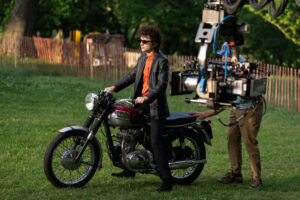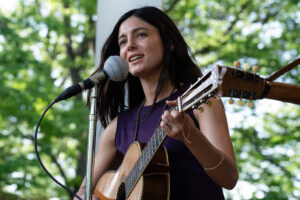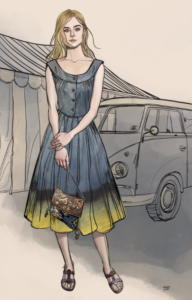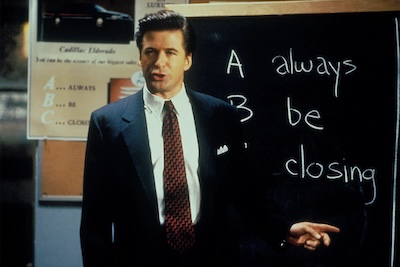Whether you are a Bob Dylan afficianado or a newbie, you will inevitably be struck by his personal style journey throughout James Mangold’s A Complete Unknown. Set between the tumultuous years of 1961 and 1965, Mangold’s film begins with Dylan’s arrival in New York City’s Greenwich Village with his guitar dangling from his fingertips. This young man will be almost recognizable as he gains fame beyond his wildest imagination, and Oscar-nominated costume designer Arianne Phillips, a die-hard Dylan fan, was meant to design for this film.
Every time that I have seen Mangold’s film, I am blown away by how it recreated this moment in time. There is excitement buzzing in the streets of New York City as Dylan wanders around in the first few moments. Phillips immediately took a moment to remind me that costume design and production design go hand-in-hand in delivering a cohesive visual representation of their story.
“François Audouy did such an incredible job recreating the West Village in New Jersey–we did it in Hoboken,” Phillips says. “We are scene partners really. He helps create the contexts of which these characters live, and he’s such a wonderful collaborator. I love working with him.”
Phillips was invigorated by what was going on in the country at this time, especially by the passion of the young people discovering who they were and how they wanted to position themselves in the world. She knew that Dylan was inspired by that passion, and she wanted to translate that into how he dressed himself.
“I was born in the ’60s, so there’s something very ephemeral about it,” she says. “It’s in me, so to speak. I love that the the ’60s is such a time of change. With this film, we are starting at the beginning of 1961, and in terms of what was happening politically, socially, especially with the youth culture movement, I feel like the best way that is expressed is through the denim story which is really when I was looking to design for A Complete Unknown. I was looking for these four years of finding out and investigating Bob’s aesthetic. When we are young, most of us are learning and embracng who we are–our identities and our relationships to the world and how we want to be perceived by the world. There are certain choices in how we dress ourselves and present ourselves in the world that can stick with us throughout our lives.”
The silhouette is very important. There are times when we see Timothée Chalamet on screen and we mistake him for the musical icon because of how Phillips’ designs elongated the actor’s frame and stature. From the top of his frazzled head to the bottom of his shoes, the costume design makes Chalamet look even taller without sacrificing Dylan’s presence on screen. What is key in that visual security? The right boots.

“We will never see Bob Dylan wearing tennis shoes or flip-flops or lace-up shoes,” Phillips jokes. “He’s a boot guy, and we see that story being told from his early proletariat worker look in the fashion of his hero, Woody Guthrie, and then we see that kind of in the middle part of our story where he’s wearing [these] kind of the cowboy boots in the 1963 Freewheelin’ era. In 1965, when he’s gone really mod, he wears the Chelsea boots, and that was a wonderful thread for me. To this day, he wears boots. Also, his hair is so iconic, and it creates this silhouette from the boots to the hair. By the end of our film, he’s really the archetype of American rock and roll. Sometimes we think of Mick Jagger or The Beatles as that archetype, but, for Americans, it’s really Bob, especially when it comes to that mod look in ’65.”
We sometimes don’t recognize how we wear jeans, but for Phillips and her designs of A Complete Unknown. The world of denim changes everything, and it lends itself to that individuality that Phillips reveres. She recognizes that Dylan is inspired by how young people take no prisoners in how they dress, and she wanted to honor how the way we dress can change our perspective.
“When we meet him, he’s wearing what would be referred to as work pants or dungarees,” she says. “Kind of like painter pants, and that’s a very baggy sihouette. In the mid-60s, his jeans get slimmer–they’re like 501s that would’ve been popular at that time. We see in ’65 that Carnaby Street-influenced, swinging ’60s look, and he’s wearing very slim denim there. I found that fascinating, because they didn’t have stretch technology fabrics, so those were very slim. When I did Once Upon a Time…in Hollywood, I purposely dressed all the Manson gilrs and a lot of the hippie characters in denim, because when you think about Woodstock at the end of that decade, you think of people barefoot and fringe and face paint. Denim is such an American story–it’s such an American cloth. It represents this youth movement that really influenced how we express ourselves. The beautiful thing about denim is the individuality and the DIY aspect of it. We wear our jeans in a personal way, and I think that mirrors our story of a young man, an artist, who leaves home at 19 from the Midwest. He’s trying to figure out his own personal style.”
When we first meet Monica Barbaro’s Joan Baez, she is wearing a black and purple printed dress, and Dan Fogler’s Albert Grossman makes a comment about how men fall head over heels for her whenever she’s on stage. The difference is, though, that she doesn’t have to try to hard, and she knows how to just exist as herself on stage as she plays her truth through her music. Phillips was interested in taking Baez color palette and style to represent the differences between her and Elle Fanning’s Sylvie. Does Baez use how she dressed to be perceived a certain way?

“Joan Baez’s style is very moden, and yet you can see that hurdle to be taken as a serious artist,” she says. “She dressed almost monastically, and she dressed almost like a nun even though she is such a beautiful young woman. Prints are important to the 1960’s, because people wore a lot of them. Doing research on Joan, it was in tandem with that, and I did do my own little color palette for Joan using her character as a representation of the East Coast even though she was West Coast based mostly in our story. I wanted to express through her dress the difference between that preppier East Coast look and the San Francisco look of the Monterey Folk Festival. San Francisco was probably more progressive, at the time, of how people dressed, and I wanted to represent being from Northern California and growing up in the ’70s and late ’60s. Even though it was sublter, it was important to me to express that sensibility in our story.
You see that when he comes to her house in Carmel, and she comes to the door to greet Bob and she’s wearing this Mexican sweater. That’s something that really came from my childhood. Whether it was her color palette of these rich jewel tones, I wanted there to be a difference between her and Sylvie, who I saw as much more a New York young woman. Sylvie is an activist and an artist, but not a musician.”
That exploration and research even extends to the jackets and coats that Baez wears. One of her most curious looks is when we see her on stage when she is wearing a fringe jacket over a modest, white dress. It makes sense to us, the viewer, because we are accustomed to how she dresses when she’s on stage. Phillips kept discovering exciting things in her research.
“That was a surprise to me,” she admits. “There’s a scene in 1964 when she’s singing on stage in a white dress that’s pleated with a bow, but she has this fringe jacket with it. I thought it was such an odd combination. Why does she have that jacket over this almost church dress? It’s very Joan. I wanted to honor the research, and she literally wore that at Newport 1964. That fringe is a real signaler to Woodstock–a Jimi Hendrix kind of jacket–and it shows her sensibility in that. This very monastic, almost conservative, non-sexualized dress paired with this cool, suede jacket that she probably picked up herself since she had money in her pocket.
Another thing that stuck out to me is that she is wearing this raincoat over shorts or dresses when she was at Newport 65, and I could never find a color picture of it. It seemed very mod, and it felt like such a weird thing like the fringe coat. I found out that it was July 1965, and a month earlier, she wore that exact coat on her album cover for “Farewell Angelina.” That was shot by Richard Avedon, who was a very famous portrait fashion photographer, and he was working for Vogue at the time. Maybe someone gave her that coat at the photoshoot, and she wore it to Newport and it became her favorite coat. Lo and behold, it wouldn’t end there.”

I expressed how even though I couldn’t pull off Chalamet’s slimmer mod looks, I wanted some of his pieces. I love the hat that Chalamet enters the film with, and Guthries has some enviable sweaters. Phillips, herself, has a lot that she would like to swipe for her own closet. Because she loves Dylan so much, she wanted to acknowledge a nod to his future.
“Elle Fanning’s dress,” she says, with no hesitation. “It is the heartbreak dress. Sylvie is, in so many ways, the heart of this movie, and the audience is so with her. I would actually take three things. I’ll take Bob’s jacket from his Freewheelin’ era. He has three of them, but I’d take the one with the bone buttons and then, of course, the polka dot shirt. After we leave him in our film, Bob’s style goes completely bananas. He’s wearing polka dot and striped suits, so I wanted to make sure that a seed was planted for that. To this day, you can find pictures of him in dots and stripes.”
A Complete Unknown is in theaters now.






![Kameron Lennox On How Ambition and Drive Fuel the Costumes of the Wild Personalities of ‘The Studio’ [VIDEO]](https://thecontending.com/wp-content/uploads/2025/06/studio-120x86.jpg)


